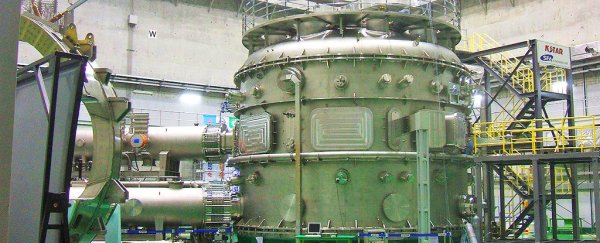Scientists working to make nuclear fusion a viable reality have smashed another record, after the Korean Superconducting Tokamak Advanced Research (KSTAR) reactor in South Korea maintained 'high performance' plasma in a stable state for 70 seconds this week– the longest ever recorded for this type of reaction.
Containing this ultra-hot type of matter is key to unlocking nuclear fusion, so it's a big step forward in our attempts to make this clean, safe, and virtually limitless source of energy something we can rely on.
Unlike nuclear fission, which our existing nuclear power plants achieve by splitting atoms, nuclear fusion involves fusing atoms together at incredibly high temperatures - the same reaction that powers our Sun.
If we can manage to control the reaction safely and sustainably it would be huge, because nuclear fusion can generate power for thousands of years using little more than salt water, and without putting out nuclear waste. And the Korean reactor just took us a step closer to that.
The KSTAR reactor is housed at the National Fusion Research Institute (NFRI) and is a tokamak-type reactor, where plasma blobs reaching temperatures of up to 300 million degrees Celsius (about 540 million degrees Fahrenheit) are held in place by super-powerful magnetic fields.
If the blobs can be contained for long enough, hydrogen atoms can fuse together to create heavier helium atoms, releasing energy – a similar process is happening on the Sun, which is why reactors are sometimes described as trying to put "a star in a jar".
And while the reactors of today take up much more energy than they produce, each time a record like this is broken, scientists get closer to their ultimate goal.
"This is a huge step forward for [the] realisation of the fusion reactor," the NFRI said in a statement, World Nuclear News reports.
There are plenty of variables scientists can alter to tweak nuclear fusion reactions and different ways they can be measured: from pressure to temperature to time.
Usually, there's a trade-off between these three variables, and indeed other reactors have managed to sustain plasma for longer periods of time – but with the KSTAR we're talking about a "high performance" plasma, which is better suited for nuclear fusion.
At the same time, the researchers at the NFRI have also developed a new plasma "operation mode" that they hope will enable reactions to handle greater pressures at lower temperatures in the future.
And getting the whole process more efficient is important if we're to get nuclear fusion working at the right scale.
If scientists can crack the "star in a jar" problem, we'd have a nuclear energy source that's far safer than the nuclear fission plants we rely on now, because no radioactive waste is produced and there's no chance of a plant meltdown.
We should note that the results haven't been published in a journal or independently verified yet, so we'll have to wait for confirmation that 70 seconds really is the new benchmark to hit for this high-performance plasma.
But as the KSTAR reactor continues to push the boundaries of what's possible, it should help bring scientists closer and closer to figuring out how to harness the potential of nuclear fusion.
As NFRI president Keeman Kim puts it: "We will exert efforts for KSTAR to continuously produce world-class results, and to promote international joint research among nuclear fusion researchers."
